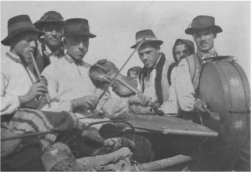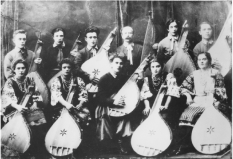—How much land did your father have?
Paraska Ivanivna: Four hectares.
—What kind of cattle did he have?
Paraska Ivanivna: Bulls, a cow, sheep, geese, and hens.
—Did you work your farmstead on your own or did you hire day laborers?
Paraska Ivanivna: At the time, no one hired day laborers.
—How much land did your grandfather have?
Paraska Ivanivna: He had the largest lot in the field—four hectares of felled forest. Then he had four morgens in each hand, and a morgen was equal to 0.6 hectares. He had two morgens behind the ravine, two more near the field in Sapizhanka, and some more near Kalytynka. He had a good deal of land but gave it away to his children when they started getting married.
—Did your grandfather hire any day laborers to work the field?
Paraska Ivanivna: Yes, but I don’t remember them.
—What crops did he grow in the field?
Paraska Ivanivna: Rye, wheat, oats, peas, mixed herbs, hemp, and potatoes.
—Was this all for the family or for sale?
Paraska Ivanivna: Everything at the time was for the family, but those who had a lot of grain would sell it. Jews lived in the village at the time, and they would buy produce.
—Do you remember the currency of those times?
Paraska Ivanivna: Mykolai’s [the Tsar’s] money.
—Did your parents go to market fairs?
Paraska Ivanivna: Yes. The market fair was in Dzhuryna. We would yoke the bulls and the horses early in the morning and leave for the fair.
—Did they sell anything?
Paraska Ivanivna: They would sometimes take wheat to sell and buy what they needed: kerosene, salt, or lard (because we didn’t keep pigs at the time). You see, we had a lot of working animals, but not production animals so we didn’t have meat or lard or our own. For some reason, we didn’t keep any pigs.
………………………………………………………………………………………..
—Do you remember the famine?
Paraska Ivanivna: The famine was major in 1932–1933. People’s bodies were swollen, and many died, but this was in other villages. In our village the famine was not so pronounced and not many people died. Only Shtefan Riabenky died. Everyone else was swollen, but survived, thank God. I know that many people died in Sadkivtsi; they were poorer there. Our people had a bit of land near the field. That land was not taxed, so we survived because of it. In other villages, people were very poor. They would bring whatever they had to other people’s houses to exchange for food. I got an icon from a woman from Sadkivtsi. I gave her two buckets of potatoes for it. One time, Petro, Buniv’s son, came; he was twelve years old and all swollen. He said, “Please, give me something to eat. I will invite you to my [future] wedding if you give me something to eat now.” I said, “Child, I hope you feel better first.” I gave him some bread. There was also Ivan Apaty whose family suffered greatly from the famine. I used to bake bean and potato bread. Just as soon as I put this dough in the oven, this guy came in and wanted to take the dough. I said, “Don’t eat the dough because it’ll make you sick. I’ll give you a piece of bread.”
………………………………………………………………………………………..
—How much did people earn in the kolhosp at the time?
Paraska Ivanivna: There were three of us working in the kolhosp: Hryhir in the workshop, Pylyp on the tractor, and I in the sugar beets field. For the whole year, we earned 144 kilograms of grain; this was our payment. How could one survive on that? The taxes were terrible. I used to sell whatever I could: cloth or blankets—anything I had—to be able to pay [taxes]. There was a guy who always stood near the administrative building telling us to pay taxes.
—Did the locals or the newcomers collect taxes?
Paraska Ivanivna: The locals. They are all dead now. Shelestian was the head [of the kolhosp?] at the time.
………………………………………………………………………………………..
—How was work distributed in the kolhosp?
Paraska Ivanivna: There was no work distribution during the harvest. Whoever could work went to the field. They would harvest the winter crops with sickles, and the spring crops were mowed and gathered. Other than that, the work inside the house was for women, and the work outside the house was done by men. In the kolhosp, all people did whatever they were told. There were, I think, three “collectives” in the village.
—Is “collective” another word for a kolhosp?
Paraska Ivanivna: Yes. We joined because we were told to. We didn’t want to join for a long time and joined only in the end. I think about forty people joined in total. Those who joined first got better land, and we got ours as far as the border Roznativske [likely a kutok]. We had average land. We used to walk over ten kilometers to that land to harvest and sheave the crops.
—Could a woman do men’s work and vice versa?
Paraska Ivanivna: It would happen, but most of the time a woman knew her work: doing laundry, cooking, whitewashing the house, and looking after the children. A man took care of the tasks in the yard, the barn, and the shed. A man took care of the cattle, threshed, and harvested the grain.
………………………………………………………………………………………..
—When was the church banned?
Paraska Ivanivna: I don’t know what year it was. I know they would go up to remove the bells.
—Were these locals or newcomers?
Paraska Ivanivna: The locals: Andrii and Yustyn Liubychankivsky. They are both dead.
—Were they Komsomol members?
Paraska Ivanivna: Yes. Everything was destroyed, dismantled. Now that the church was reopened, people flock there like bees to honey. It’s nice in the church now; time will tell.
—Were the priests persecuted at the time? What was the village priest like?
Paraska Ivanivna: Zholudkevych. He was expelled.
—Was he a local?
Paraska Ivanivna: No.
—What was his name?
Paraska Ivanivna: I know his last name was Zholudkevych; I don’t know his first name. The girl’s name was Klara. They were expelled, and God knows where he is now. He left, and who knows, maybe they were killed.
………………………………………………………………………………………..
—Do you remember how you used to sing koliadky?
Paraska Ivanivna: Older guys from the church used to go. They would take a donation box with them and go from house to house. House owners would put money in the donation box for church needs, and the singers would get bread and stuffed pastry.
—How much did people give for the church needs?
Paraska Ivanivna: Twenty or thirty kopeks. The money in the box was considered church money.
—Did only men sing koliadky or did women sing, too?
Paraska Ivanivna: At the time, it was men only. They didn’t take women with them. Now people from the church go singing again, so there are more women. Nowadays everything is different. What can you say?



